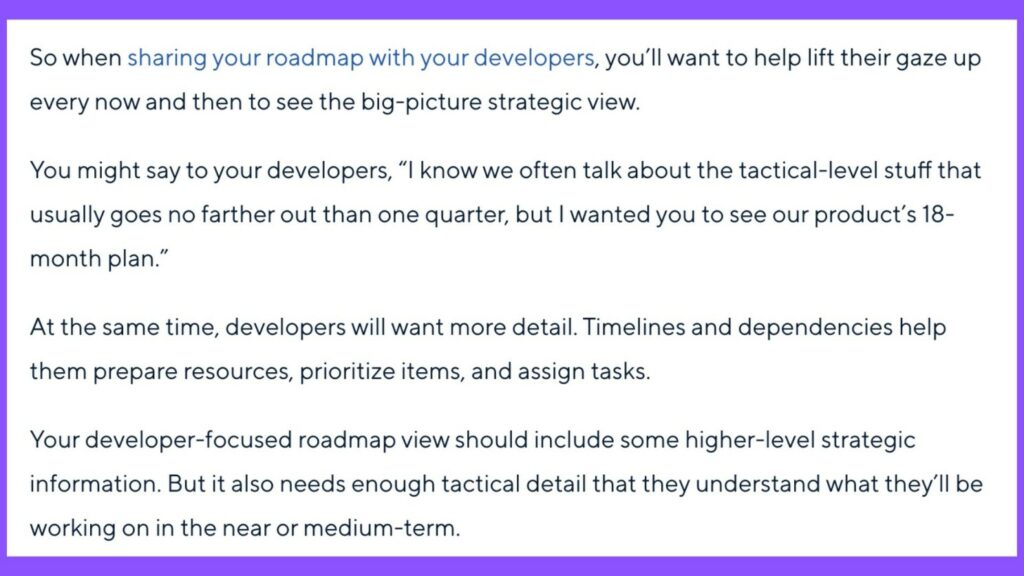In any product-led organisation, the product roadmap is often viewed as the backbone of execution.
It’s the what and when that keep teams aligned, and for product managers, it’s the vision that drives the product’s evolution.
But here’s the catch: the product roadmap means something different to every team and each team must understand it from their perspective.
If you want your product team to work cohesively, it’s essential to break the silos because every department, from sales to engineering, has a unique lens on the roadmap.
Here’s how each team uses the product roadmap—and why transparency across the board is super important.
For You (The Product Manager): The Vision of Evolution
Use case: Product managers rely on the roadmap to determine the product’s direction. It’s the “north star,” offering clarity on which features and improvements will best serve the customer and align with business goals in the short, medium and long term.
A solid roadmap is a guide that helps product managers make informed decisions. It keeps you focused on why the product should evolve in a certain way, ensuring that every feature aligns with both customer needs and company strategy.
For Sales & Marketing: The Promise of What’s Coming
Use case: For sales and marketing, the product roadmap is a promise. It’s the document they lean on to tell customers, partners and prospects what’s on the horizon.
Scenario: Imagine a sales rep talking to a prospect. They promise a feature that will drastically improve the product experience—except it’s not even on the roadmap yet. Without visibility into upcoming product features, sales teams risk overpromising and underdelivering. A transparent roadmap prevents this by keeping the sales team informed about what’s coming and when.
Take a look at the video below by tldv on TikTok, which perfectly describes what it’s like when the sales team is ahead of the rest of the team. If you work in a B2B company, you know that your sales team is your face card.
@tldv.io I am but a puppet
♬ original sound – tldv.io – AI Meeting Recorder
When the sales and marketing teams have insight into the roadmap, they can align their messaging, nurture leads, and even close deals with confidence, knowing exactly what to expect from the product and what to tell customers.
For Engineering: A Preview of What’s Ahead
Use case: Engineers need to anticipate upcoming features so they can plan for the necessary infrastructure and technical resources.
Now, picture this: an engineering team is tasked with building a new feature, but they weren’t clued in on the roadmap’s broader strategy. As a result, they discover midway through development that a critical infrastructure change is required—a change they could’ve anticipated if they had been brought into the conversation earlier. This can lead to costly delays, confusion and rework.

When engineering teams are kept in the loop, they can plan more effectively, allocate resources more efficiently, and create scalable solutions that seamlessly integrate with upcoming features.
For Customer Support: Enhancing Customer Experience and Readiness
Customer Support (CS) teams are critical stakeholders in a product roadmap. Here’s how roadmaps influence them and why alignment is essential:
Use Case: CS teams need the product roadmap to prepare for upcoming features, improvements, or potential issues that customers may encounter.
Imagine a Saas company preparing to roll out a significant update to its app or software. The product roadmap outlines that the feature will require additional steps during onboarding. If the CS team is aligned, they can:
- Send proactive communications to customers about how the feature will benefit them and any necessary adjustments they’ll need to make.
- Update their FAQs and help centre with clear documentation.
- Train your support agents on the new feature to ensure they are equipped to assist users.
Customer support teams are the face of your company. When they are well-informed about upcoming product changes, they can create moments of delight by resolving issues quickly and proactively.” — Shep Hyken (Customer Experience Expert)
If the CS team isn’t looped in, they might find themselves blindsided by a sudden influx of customer complaints or questions, which could result in unnecessary friction for the customer experience.
For Senior Management: Aligning the Vision with Business Goals
Use case: Senior management uses the roadmap to communicate the vision to investors, the board and internal teams, ensuring that everyone is aligned on the product’s strategic direction.
A typical scenario for this is when senior management presents a product update to the board, but the roadmap isn’t well communicated, and key stakeholders don’t understand the product’s future direction.
The risk here is a disconnect—when the roadmap isn’t clearly aligned with the company’s vision, senior leadership struggles to gain support and buy-in.
Pro Tip: When senior management is transparent about the roadmap, they can effectively communicate long-term goals, secure funding and rally internal teams around a shared vision.
Why Every Team Needs to Be On the Same Page
Transparency in the roadmap fosters collaboration, minimizes miscommunication and allows teams to make decisions with context.
In fact, product success is built on communication, and when all teams understand the vision and strategy laid out in the roadmap, they can act proactively, not reactively. This is what keeps your product on track and ensures it meets both customer needs and business objectives.
The outcome: a stage for smoother execution, fewer surprises, and more successful product launches.
Check Courses for Skills You Need to Build Now.

